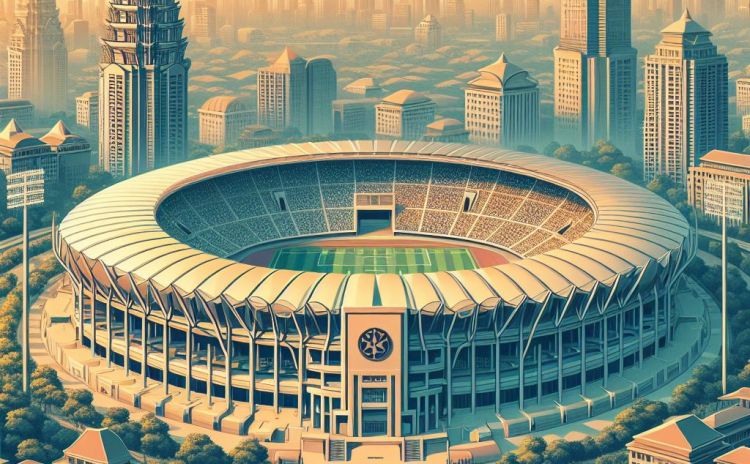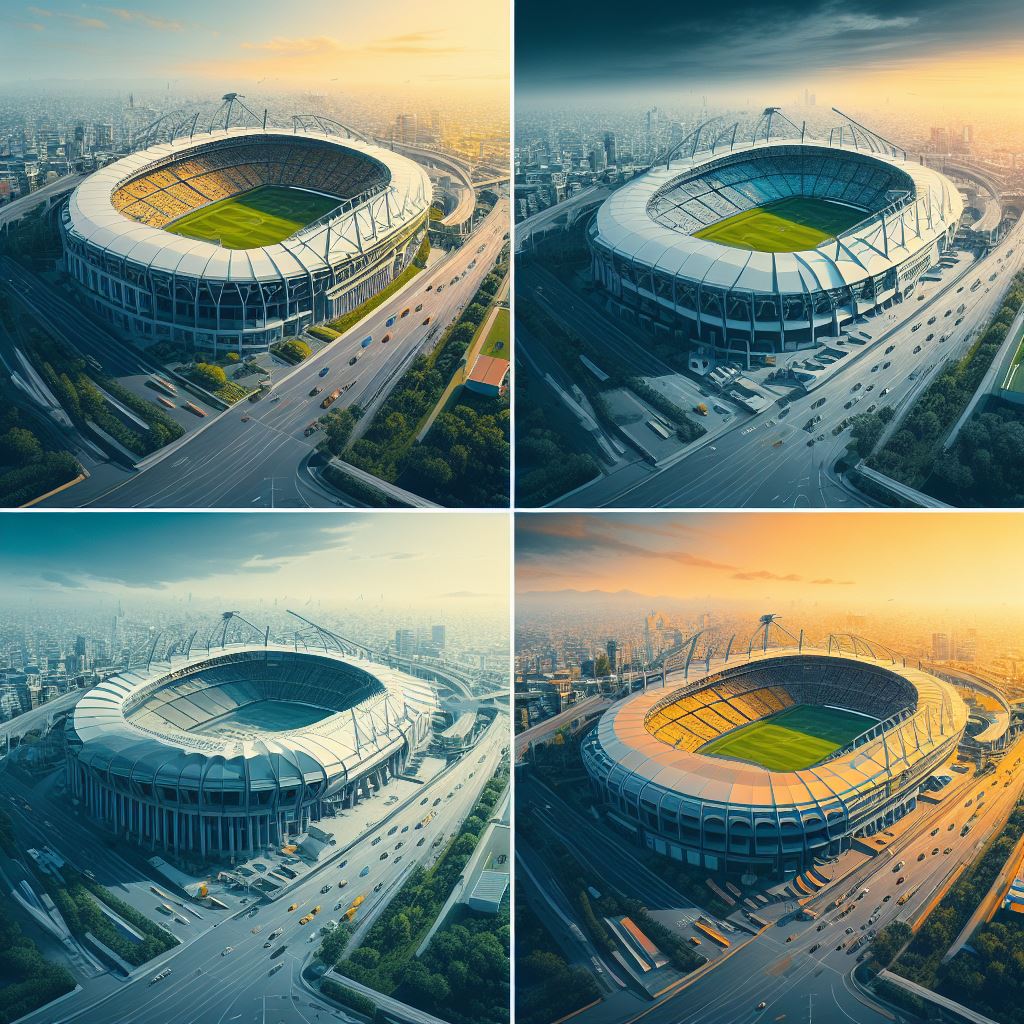
Outline of the Article
- Discover the largest stadiums in Cambodia and their cultural significance
- Presentation of the topic and the question
- Announcement of the plan of the article
- The Morodok Techo National Stadium
- Capacity and features
- History and construction
- Events and uses
- The Olympic Stadium of Phnom Penh
- Capacity and features
- History and construction
- Events and uses
- The RSN Stadium
- Capacity and features
- History and construction
- Events and uses
- The Svay Rieng Stadium
- Capacity and features
- History and construction
- Events and uses
- The Prince Stadium
- Capacity and features
- History and construction
- Events and uses
- Conclusion: Summary and final thoughts
- FAQs: Five frequently asked questions and answers
Use the $5 free bet on sportsbook to play online on events at Cambodia's biggest stadiums
Discover the largest stadiums in Cambodia and their cultural significance
Cambodia is a country in Southeast Asia with a passion for football. The country has several stadiums where national league matches, international competitions and sporting events are held. But do you know what are the largest stadiums in Cambodia? How many people can they accommodate? When and how were they built? What kind of events do they host? In this article, we will answer these questions and more. We will present you the five largest stadiums in Cambodia, their capacity, their history and their uses. You will be surprised by some of them!

The five largest stadiums in Cambodia are:
- The Morodok Techo National Stadium
- The Olympic Stadium of Phnom Penh
- The RSN Stadium
- The Svay Rieng Stadium
- The Prince Stadium
Let's take a closer look at each of them.
The Morodok Techo National Stadium
Capacity and features
The Morodok Techo National Stadium is the newest and most modern football stadium in Cambodia. It was inaugurated in 2017 by Prime Minister Hun Sen, who donated it to the Cambodian people. It can accommodate up to 75,000 spectators and has a natural grass pitch. It is located in Kandal province, about 15 km north of Phnom Penh. The stadium has a unique design that resembles a sailing ship, symbolizing the country's maritime history and culture. It also has a roof that covers the entire seating area, protecting the fans from the sun and the rain. The stadium is equipped with state-of-the-art facilities, such as LED screens, sound systems, lighting systems, security systems and fire protection systems. The stadium is part of a larger complex that includes a swimming pool, a tennis court, a gym, a hotel and a park.
History and construction
The Morodok Techo National Stadium was built with the help of China, which provided a grant of $160 million for the project. The construction started in April 2013 and was completed in August 2017. The stadium was designed by the China State Construction Engineering Corporation, which also built the Beijing National Stadium for the 2008 Olympics. The stadium was built to meet the standards of FIFA, the International Association of Athletics Federations and the Olympic Council of Asia. The stadium was officially opened on September 6, 2017, with a ceremony that featured cultural performances, fireworks and speeches by the Prime Minister and the Chinese Ambassador. The stadium hosted its first football match on September 9, 2017, between the Cambodia national football team and the Laos national football team, which ended in a 2-2 draw.
Events and uses
The Morodok Techo National Stadium is the venue for the 2023 Southeast Asian Games, which Cambodia is hosting for the first time in its history. The stadium will host the opening and closing ceremonies, as well as the athletics and football events. The stadium also hosts the matches of the Cambodia national football team, as well as those of the national football championship. The stadium is also used for other sporting events, such as rugby, volleyball, basketball and martial arts. The stadium is also open to the public for recreational activities, such as jogging, cycling and skating. The stadium is a symbol of the progress and development of the country, as well as its willingness to host international sporting events.
The Olympic Stadium of Phnom Penh
Capacity and features
The Olympic Stadium of Phnom Penh is the oldest and most famous football stadium in Cambodia. It has a capacity of 50,000 and has a natural grass pitch. It is located in the heart of the capital, 500 m from the Orussey Market and 2 km from the Night Market and the Tonle Sap River. The stadium has a distinctive design that reflects the Khmer architecture and culture. It has a circular shape that represents the sun, and four towers that represent the four elements of earth, water, fire and air. The stadium has a concrete structure that is resistant to earthquakes and floods. The stadium has basic facilities, such as toilets, locker rooms, ticket booths and snack bars. The stadium is surrounded by a park that has a swimming pool, a tennis court, a volleyball court and a gym.
History and construction
The Olympic Stadium of Phnom Penh was built between 1963 and 1964, under the reign of Prince Norodom Sihanouk, who wanted to modernize the country and promote sports and culture. The stadium was designed by the famous Cambodian architect Vann Molyvann, who was inspired by the Angkor Wat temple and the ancient Khmer civilization. The stadium was built with the assistance of China, which provided technical and financial support. The stadium was inaugurated on November 9, 1964, with a ceremony that featured a parade, a speech by the Prince and a football match between Cambodia and Malaysia, which Cambodia won 3-1. The stadium was named the Olympic Stadium because it was intended to host the 1967 Southeast Asian Peninsular Games, which were cancelled due to the political turmoil in the country. The stadium was also used for other events, such as concerts, festivals and rallies.
Events and uses
The Olympic Stadium of Phnom Penh is the main venue for the national football league, which features 12 teams from different provinces. The stadium also hosts the matches of the Cambodia national football team, as well as those of the national futsal team. The stadium also hosts other sporting events, such as athletics, boxing, taekwondo and wrestling. The stadium also hosts cultural events, such as concerts, festivals and ceremonies. The stadium is also a popular place for the local people, who use it for exercise, relaxation and socialization. The stadium is a landmark of the city and a witness of the history and culture of the country.
The RSN Stadium
Capacity and features
The RSN Stadium is one of the newest and most modern football stadiums in Cambodia. It has a capacity of 10,000 and has an artificial turf pitch. It is located in the Tuol Kork district of Phnom Penh, 5 km from the Royal Palace and the National Museum. The stadium has a simple design that consists of a rectangular shape and a metal roof. The stadium has advanced facilities, such as LED screens, sound systems, lighting systems, security systems and fire protection systems. the stadium is part of the Rithy Samnang Group, which owns the Phnom Penh Crown FC, one of the most successful football clubs in Cambodia. The stadium is the home ground of the Phnom Penh Crown FC, which plays in the Cambodian League. The stadium is also used for other sporting events, such as rugby, hockey and badminton. The stadium is also open to the public for recreational activities, such as jogging, cycling and skating. The stadium is a symbol of the ambition and excellence of the Rithy Samnang Group, as well as its contribution to the development of sports and entertainment in Cambodia.
History and construction
The RSN Stadium was built in 2015, with the investment of $3 million by the Rithy Samnang Group. The construction was completed in six months, with the help of the China Railway Construction Corporation, which also built the Beijing National Stadium for the 2008 Olympics. The stadium was designed by the Cambodian architect Sok Sophea, who was inspired by the modern and minimalist style. The stadium was inaugurated on November 14, 2015, with a ceremony that featured a speech by the owner Rithy Samnang, a performance by the singer Preap Sovath and a football match between Phnom Penh Crown FC and Boeung Ket Angkor FC, which Phnom Penh Crown FC won 3-0.
Events and uses
The RSN Stadium is the venue for the Cambodian League, which is the top division of the Cambodian football system. The stadium hosts the matches of the Phnom Penh Crown FC, which has won the league six times, the most of any club. The stadium also hosts the matches of the Hun Sen Cup, which is the national knockout cup competition. The stadium also hosts international matches, such as the AFC Cup, which is the second-tier club competition in Asia. The stadium also hosts other sporting events, such as rugby, hockey and badminton. The stadium also hosts cultural events, such as concerts, festivals and ceremonies. The stadium is also a place for the local people, who use it for exercise, relaxation and socialization. The stadium is a landmark of the city and a showcase of the quality and professionalism of the Rithy Samnang Group.
The Svay Rieng Stadium
Capacity and features
The Svay Rieng Stadium is one of the oldest and most historic football stadiums in Cambodia. It has a capacity of 10,000 and has a natural grass pitch. It is located in the Svay Rieng province, about 120 km east of Phnom Penh. The stadium has a simple design that consists of a rectangular shape and a metal roof. The stadium has basic facilities, such as toilets, locker rooms, ticket booths and snack bars. The stadium is surrounded by a park that has a swimming pool, a tennis court, a volleyball court and a gym.
History and construction
The Svay Rieng Stadium was built in 1965, under the reign of Prince Norodom Sihanouk, who wanted to promote sports and culture in the rural areas. The stadium was designed by the Cambodian architect Vann Molyvann, who also designed the Olympic Stadium of Phnom Penh. The stadium was built with the assistance of the Soviet Union, which provided technical and financial support. The stadium was inaugurated on December 25, 1965, with a ceremony that featured a speech by the Prince and a football match between Cambodia and the Soviet Union, which Cambodia lost 0-4. The stadium was named the Svay Rieng Stadium because it was located in the Svay Rieng province, which was the birthplace of the Prince. The stadium was used for other events, such as concerts, festivals and rallies.
Events and uses
The Svay Rieng Stadium is the venue for the Cambodian League, which is the top division of the Cambodian football system. The stadium hosts the matches of the Preah Khan Reach Svay Rieng FC, which is one of the most successful football clubs in Cambodia. The stadium also hosts the matches of the Hun Sen Cup, which is the national knockout cup competition. The stadium also hosts international matches, such as the AFC Cup, which is the second-tier club competition in Asia. The stadium also hosts other sporting events, such as athletics, boxing, taekwondo and wrestling. The stadium also hosts cultural events, such as concerts, festivals and ceremonies. The stadium is also a place for the local people, who use it for exercise, relaxation and socialization. The stadium is a landmark of the province and a witness of the history and culture of the country.
The Prince Stadium
Capacity and features
The Prince Stadium is one of the newest and most modern football stadiums in Cambodia. It has a capacity of 15,000 and has an artificial turf pitch. It is located in the Phnom Penh province, about 10 km northwest of Phnom Penh City. The stadium has a unique design that resembles a lotus flower, symbolizing the beauty and purity of the country. It also has a roof that covers the entire seating area, protecting the fans from the sun and the rain. The stadium is equipped with state-of-the-art facilities, such as LED screens, sound systems, lighting systems, security systems and fire protection systems. The stadium is part of a larger complex that includes a hotel, a casino, a shopping mall and a park.
History and construction
The Prince Stadium was built in 2019, with the investment of $20 million by the Prince Group, which is one of the largest conglomerates in Cambodia. The construction was completed in 10 months, with the help of the China Railway Construction Corporation, which also built the Beijing National Stadium for the 2008 Olympics. The stadium was designed by the Chinese architect Li Xinggang, who also designed the Beijing National Stadium. The stadium was built to meet the standards of FIFA, the International Association of Athletics Federations and the Olympic Council of Asia. The stadium was officially opened on December 21, 2019, with a ceremony that featured a speech by the owner Chen Zhi, a performance by the singer Meas Soksophea and a football match between Cambodia and Malaysia, which Cambodia won 3-1.
Events and uses
The Prince Stadium is the venue for the Cambodian League, which is the top division of the Cambodian football system. The stadium hosts the matches of the Visakha FC, which is one of the most successful football clubs in Cambodia. The stadium also hosts the matches of the Hun Sen Cup, which is the national knockout cup competition. The stadium also hosts international matches, such as the AFC Cup, which is the second-tier club competition in Asia. The stadium also hosts other sporting events, such as rugby, volleyball, basketball and martial arts. The stadium also hosts cultural events, such as concerts, festivals and ceremonies. The stadium is also a place for the tourists, who can enjoy the facilities and attractions of the complex. The stadium is a landmark of the city and a showcase of the quality and professionalism of the Prince Group.
Conclusion: Summary and final thoughts

In this article, we have presented you the five largest stadiums in Cambodia, their capacity, their history and their uses. We have seen that the stadiums are not only places for sports and entertainment, but also symbols of the progress and development of the country, as well as its history and culture. We hope that you have learned something new and interesting about the largest stadiums in Cambodia, and that you will visit them someday. Thank you for reading!
FAQs: Five frequently asked questions and answers
Here are some of the frequently asked questions about the largest stadiums in Cambodia:
- What is the name of the largest stadium in Cambodia?
The name of the largest stadium in Cambodia is the Morodok Techo National Stadium, which has a capacity of 75,000.
- When was the Olympic Stadium of Phnom Penh built?
The Olympic Stadium of Phnom Penh was built between 1963 and 1964, under the reign of Prince Norodom Sihanouk.
- Which football club plays at the RSN Stadium?
The football club that plays at the RSN Stadium is the Phnom Penh Crown FC, which is one of the most successful football clubs in Cambodia.
- Who designed the Svay Rieng Stadium?
The Svay Rieng Stadium was designed by the famous Cambodian architect Vann Molyvann, who also designed the Olympic Stadium of Phnom Penh.
- What is the shape of the Prince Stadium?
The shape of the Prince Stadium is a lotus flower, which symbolizes the beauty and purity of the country.

